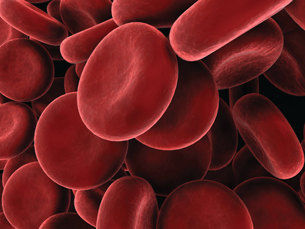Module 8 Intro
1. Module 8 Intro
1.18. Page 3
Module 8—Circulation, Immunity, and Excretion
 Read
Read
The Function of Blood
Transport: Red Blood Cells

© Sebastian Kaulitzki/shutterstock
Red blood cells (erythrocytes) are the most plentiful cells in your blood. Women average 4.8 million RBCs/microlitre of blood. Men average 5.4 million RBCs/microlitre of blood. A microlitre is one-millionth of a litre. The number of blood cells can vary depending on health and altitude. At high altitudes, in order to cope with lower concentrations of oxygen, the body will increase red blood cell production.
Red blood cells are responsible for the transport of oxygen and carbon dioxide. The hemoglobin molecule makes it possible for RBCs to carry oxygen. When blood is pumped to the lungs, conditions in the blood cause hemoglobin to bind with oxygen. As the blood moves to capillaries in the lungs, there is a lower temperature, a higher pH, and an increase in oxygen pressure.
Oxygen, which has diffused through the alveoli, binds with the hemoglobin in the red blood cells. The hemoglobin is returned to the heart to be pumped to the rest of the body. As blood moves to capillaries in the rest of the body, there is a higher temperature, a lower pH, and lower oxygen pressure in the tissues. At this point, hemoglobin will give up its oxygen. Oxygen then diffuses into cells to be used as the final electron acceptor for cellular respiration.
Cellular respiration produces carbon dioxide. Most carbon dioxide is transferred into the RBC by diffusion, while some carbon dioxide remains in the plasma. Once inside the red blood cell, about half of the CO2 binds to sites on the hemoglobin molecule. The rest of the carbon dioxide will combine with water to form carbonic acid.
Carbonic acid dissociates into hydrogen ions(H+) and bicarbonate ions (HCO3-). Bicarbonate ions will diffuse back into the plasma. Hydrogen ions will bind to the hemoglobin molecule and therefore not increase the pH of the blood.
CO2 + H2O ↔ H2CO3 ↔ H+ + HCO3−
When red blood cells reach the lungs, the above reaction is reversed. Bicarbonate ions enter the red blood cells and combine with hydrogen ions to form carbonic acid. This is broken down into carbon dioxide and water. Carbon dioxide diffuses out of the red blood cells into the alveoli where carbon dioxide is released.
Anemia is a condition that occurs when there are too few red blood cells or too little hemoglobin inside red blood cells. Oxygen flow is reduced and a person will be tired and appear pale. Anemia can be caused by a lack of iron, which is a key component of hemoglobin. A diet that includes iron-rich foods such as red meat (in particular, liver), broccoli, and lentils can help alleviate anemia. You can also take iron supplements.
RBCs are terminally differentiated, which means they can never divide. They have a lifespan of about 120 days. Liver and spleen cells ingest blood cells at the end of their life cycles, and the iron from hemoglobin is reabsorbed into the body. The remaining portion of the blood cells are degraded into bile pigments, which are secreted by the liver. The liver scavenges approximately three million RBCs per second.